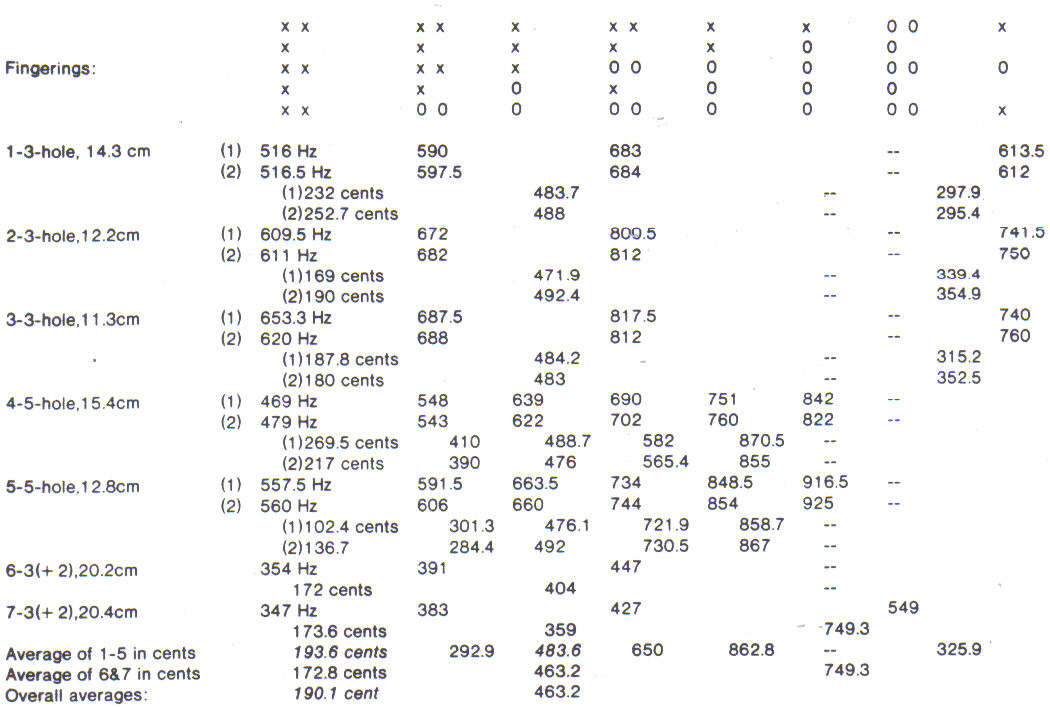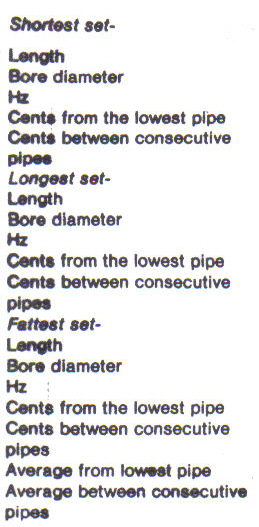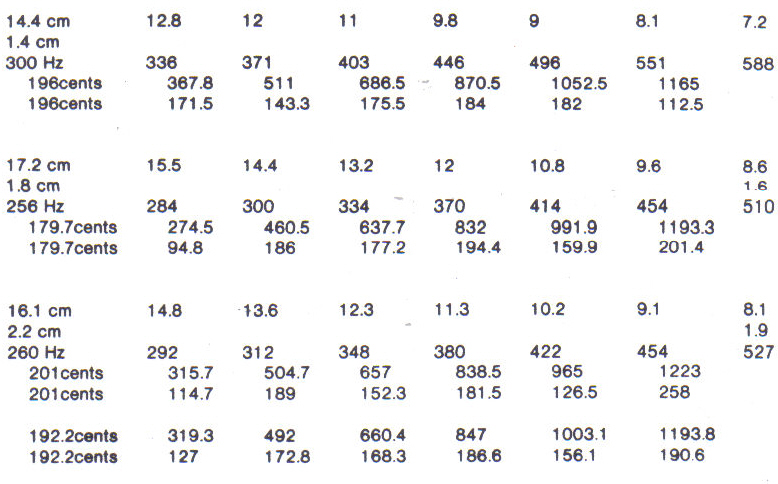Isometrics and the Origins of Modal Systems: A Brief
Experimental Inquiry
Tom Amos
Victor Belaiev
and Kathleen Schlesinger have posited theories for the origin of modal systems based on the
linearly equal placement of finger holes on wind instruments and frets on string instruments. Belaiev calls this technique of placement "metric temperament".
Schlesinger calls the technique "isometrics" based upon a passage from Aristotle's Harmonics that is rather problematical in translation. I am using Schlesinger's term merely
because hers is from an earlier work and is shorter.1
Schlesinger's work with the Greek autos
led her to the conclusion that the ancient Greek scales could be obtained on that instrument by the equal
spacing of six holes below
the double reed with further adjustments for the various genera to be accommodated by tuning bands.
Her arguments tend to be inconsistent in that she allows certain unequal spacings,
and several of the examples of
surviving auloi that she presents appear to be
directly contradictory to her assertions.2
Belaiev presents a model for the origin of various Soviet
ethnic modal systems based
on the division of those points which yield fourths, into halves. From these divisions is derived a trichord which Belaiev claims can
be used as a model for a
pentatonic scale if one overblows the trichord at the fourth (eleventh) or fifth (twelfth). The actual intervals
described are a second of 231 cents and a fourth of 498 cents.3 The
most obvious weakness of Belaiev's theory is his failure ate a method for arriving at the initial fourths.
J. V. S. Megaw, in his article
"Pennywhistles and Prehistory", mentions that the
majority of bone fipple-flutes that exist from the Paleolithic have equally spaced
holes which seem to correspond to the "natural" lie of the three
fingers of the right hand on the flute. He fails to present any
measurements of distances, proportions, or frequencies.4
Experimental Model
Whatever the shortcomings of the previous studies,
there seemed to be some evidence that in some way equal measurements
had something to do with scale formation.
Inspired by this earlier research, I formulated an experimental model
of my own. I wished to discover what scale or patterns would arise if simple
fipple-flutes were constructed which had holes bored at points halfway from the
front edge of the fipple and the end of the flute, and then two more holes equidistant
from the first hole back towards the fipple and also towards the end of the flute, thus:

Five
of these three-hole flutes were constructed. Later, two more flutes were built with two more holes
equidistant between the center and two outer holes.
I also made a flute with three finger-holes spaced according to the "natural"
lie of three of my fingers at an arbitrary, but somewhat central, location
on the flute. Two of the earlier flutes had finger-holes added according to this
procedure with the original center-hole maintaining a position between the two
new holes. These two altered flutes had hole distances
determined by the right hand of one of my room mates.
Further
three sets of pan-pipes were constructed, each consisting of eight bamboo
pipes cut consecutively from the natural divisions of the grass. These sets of pipes, each cut from one stalk, were then
placed against a wall and arranged in
the order in which they came from the plant. The first pipe cut was measured
but left unaltered, the last pipe was marked at half the length of the first, and a diagonal line was drawn across the
row of eight adjacent pipes from the end of the first, to the point marked on
the last. The pipes were then cut at the
highest point on each pipe which was intersected by the diagonal line. Thusly:

All the instruments, pipes and flutes alike, were
made of bamboo, as this is a readily available tubular material throughout the world. Steel tools
were used largely
for convenience, the general unavailability of stone cutting tools in Modern America, and my lack of skill with stone
tools if they were available. All hole measurements were made with a piece of string approximately an
eighth of an
inch in diameter, which was folded in half as appropriate to achieve the divisions by half and quarter as required.
This experiment works from the presupposition of a
culture without a predetermined
scalar-modal system which has the technology to produce fipple-flutes or pan-pipes, and a concept of mathematics
and measuring sufficient
to derive halves and quarters. Such a culture may have existed in the late Paleo!ithic
for all that I have been able to determine. I was interested in finding concurrences with surviving scalar-modal
practices, or with Belaiev's theories. I also wanted to determine if fourths and
fifths arose from these simple
arithmetical relationships.
Methods
As steady as possible tones were blown
on the flutes and pipes, trying as much as possible to blow steady fundamentals
and avoid over-blowing. These were matched by my ear to sine-wave frequencies produced on Professor F.R. Moore's self-made digital synthesizer,
nick-named the FRMbox, at UCSD. When, after a series of attempts of no
less than 30 seconds in duration for each note, a subjectively convincing result was
achieved, it was written down. As little "beating" as possible
between the frequencies produced by the synthesizer and the instruments
constituted a convincing result. The FRMbox has an accuracy to 1/6 Hz with a precision of 1 in 224 (16 million-odd)
parts.
This question of accuracy versus
precision was reflected in other parts of the experiment. While it was possible to
determine the precision of cents derived from results of frequency matching, due to the precision of
modern pocket calculators,
it was very difficult to achieve an accuracy of more than .5 Hz in frequency due to several factors.
With these fipple-flutes and pan-pipes it is quite easy to bend the pitches as much as a
whole-tone. One also has a temptation,
coming from a culture with predetermined scalar-modal systems, and with training or prejudice in those
systems, to blow notes which accommodate those systems. Further variations can occur from test to test due
to changing humidity and
barometric pressure, and the inevitable lack of precision between instruments caused by the
primitive measuring system employed. The FRMbox, with its extreme precision and accuracy, is
itself subject to fluctuations
in current from its regional power-grid. Excluding all of the previous qualifiers, I believe that I at least
compensated for my cultural biases to some extent, by the imposition of the 30 second test
duration for each note. As I do not possess absolute pitch, this duration affected my tonal memory for
long series of pitches on any one instrument.
All frequencies were converted from
octal numbers to base ten. Cents were derived following the formula: cents = log10 F2 / F1
/ 1og 10 2 X 1200. The first five fipple-flutes
constructed were all tested two times. The latter three sets of fipple-flutes, and the three sets of
pan-pipes, were tested only once
each due to the sensitivity of the FRMbox to humidity
without a permanent home,
and the unusually wet weather in California (for the third straight year) during the period of the experiment.
 .
.
Table 1:
3- and 5-hole Flutes
Italicized numbers are the most relevant to Belaiev's trichordal
pentatonic model

Table 2: Flutes
with 3 Holes Spaced According to the "Natural" Lie of the Fingers
Italicized numbers are the most relevant to
Belaiev's trichordal pentatonic model.
Results
Fingerings
for the 3 and 5-hole flutes are shown in tandem to compare the results from
isometric hole ratios in proportion to over-all
length.
The two flutes (6,7) with 2 holes
added according to the "natural" lie of the fingers are included as 3-hole isometric flutes in Table I and as 3-hole
"natural" tie flutes in Table II. The following is a list of
the symbols and their meanings in Table I.
— = no believable result.'
Lengths are given in centimeters.
Frequencies are given in Hertz.
(1)
= first test.
(2)
= second test.
x = closed finger-hole.
0 = open finger-hole.
3(+ 2) = 3-hole flutes altered by the addition of 2 holes to equal 3-hole
"natural" lie flutes. When they equal these instruments, the
outer finger-holes
are always closed. Results are in Table II.
My first discovery with the smaller (11.3 to 15.4 cm in
length) 3 and 5-hole fipple flutes was that a fourth with an average of 483.6
cents could be obtained with the fingering
 on the 3-hole flutes, and
on the 3-hole flutes, and
 (which
gives the same hole distance proportions) on
the 5-hole flutes. These fourths varied by only 20.5 cents. Apparently though, these fourths apply only
to flutes of these approximate lengths and diameters (1.5-1.8 cm)
because the two larger 3-hole flutes (20.2-20.4 cm) yielded an average of 381.5
cents with these fingerings. A fingering of
(which
gives the same hole distance proportions) on
the 5-hole flutes. These fourths varied by only 20.5 cents. Apparently though, these fourths apply only
to flutes of these approximate lengths and diameters (1.5-1.8 cm)
because the two larger 3-hole flutes (20.2-20.4 cm) yielded an average of 381.5
cents with these fingerings. A fingering of
 (
(
 for 5-hole
flutes resulted in seconds with an average of 193.6 0 cents for the smaller
flutes and 172.8 cents for larger flutes.
for 5-hole
flutes resulted in seconds with an average of 193.6 0 cents for the smaller
flutes and 172.8 cents for larger flutes.
The cent values for these seconds and fourths are
particularly relevant to Belaiev's theory,
yet, these values seem to fluctuate too widely to consistently support his theories. Perhaps only certain size
ranges of flutes fall into Belaiev's trichord theory. His theory has another weakness that I
observed. None of my instruments
could be over-blown at the fourth or fifth to fill out his model of
pentatonic scale formation from metrically tempered trichords.
I find it unlikely that Belaiev's
theory of metric temperament holds water for any wide range of wind
instruments, due to the consistency of end pressure regardless of the over-all length of an instrument. Nevertheless,
his theory bears considerably more investigation; my
study is not broad enough statistically to completely refute his assertions.


Table 3:8-Pipe Pan Pipes
So
far as conclusions specifically regarding scalar formation employing the simple
fingerings given for isometrically hold 5-hole flutes
in Table I, the variations between the individual instruments are rather
great. The only consistency I was able to
find, within an unacceptably small sample, was a sharp minor sixth with
an average of 862.5 cents and a fingering of
 .
.
The 3-hole flutes
spaced according to the "natural" lie of the fingers produced wildly
varying results from which no firm conclusions can be drawn. 50 cents
constitutes a wide variation from any interval defined as central for the
purposes of these experiments. The smallest flute of the previously mentioned group, probably coincidentally, gave results
fairly closely in accord with Belaiev's trichord. These three flutes had been constructed to see if
the Paleolithic bone flutes (translated to bamboo in these experiments)
mentioned by Megaw gave any consistent interval results. There is a
possibility of consistency among the paleolithic bone flutes due to the fact that they are generally
made from sheep tibia and may, therefore, be of similar size. This makes an
assumption of an average hand size (same species or gene-pool of Homo ?), and a consistent placement of the
fingers on the bone flutes for measuring purposes. The
testing of this hypothesis would involve access to :!l of the bone flutes
mentioned by Megaw for measurement; finger placements
from a large number of individuals of similar physical characteristics; and
access to many tibia from a race of sheep similar to those from
which these flutes were constructed!
One
coincidence which, for lack of a better term, I will call a pseudo-consistency, involves the fingerings or which divides
the flute in half from the front of the fipple to the end of the flute. These
fingerings produced thirds averaging
325.9 cents for 3 and 5-hole isometrically spaced
flutes, and 318.8 cents for 3-hole
flutes with "natural" lie finger placement. The range of the intervals was 241.8 to 410.5 cents.
Although this is an extraordinarily large range of cents, perhaps this relates in some way to various theories
which claim that chains of thirds are
the basis for "primitive" scalar-modal systems.5 Apparently divisions by halves are the easiest to make.
The 8-pipe
pan-pipes resulted in heptatonic scales closed by near
approximations of the octave (1165, 1193.3, and 1223 cents). Although there was
considerable
variation between the results for each set of pipes, when the gamut of each set was run, the results seem
similar to modes or scales that would be familiar to contemporary western listeners. The
modes are "minorish"; in a
Dorian or Aeolian sense, subjectively.
The use of
eight pipes, with the shortest being 1/2 the length of the longest prejudices this experiment in favor
of octaves and heptatonic scales, the most familiar types for contemporary
western listeners. That intervals close to major seconds are so predominant, (if 160 to 202
cents can be called major seconds), or
15 out of 21 intervals, perhaps aides in achieving this similarity to
contemporary scalar-modal systems.
The fact
that 9 of 11 instruments produced fourths (460.5 to 511 cents,
with an average of ca. 478 cents) would
seem to indicate, at least tentatively, that these intervals, along with thirds and
seconds, would become readily established in the minds of early instrument makers, using simple, isometric
measurements, merely by the frequency of their
occurrence.
Summation
Although the production of tones on any of these wind instruments is highly
dependent on many variables including air pressure to the instrument from the
player to the instrument, barometric pressure, humidity, and cultural conditioning; it appears that certain types of intervals
(some seconds, thirds, and fourths) result from simple isometric measurements. How one defines these
intervals is dependent
upon numerous mathematical models ranging from the ancient Chinese and Greeks, to such near contemporaries as Harry Partch.
Instead of quibbling over the exact number of cents
in a fifth, fourth, major of minor third, or second, I propose an approach to future studies of
the origin of
scales based on generalizations of intervals and scales. In other words, what is more important than levels of preciseness that
can only be achieved by the technologies of literate societies, may be the definition and usage of
such concepts
as "fourth-ness", "pentatonicness",
or "diatoniclike". Given that when such a highly sophisticated, theoretically defined
pitch artifact as a symphony orchestra plays, the violinist goes sharp during fast, loud passages,
while the
xylophonist is restricted to a fixed tuning, yet there seems to be a culturally
perceptible pitch-system, it seems reasonable to
assume that such inconsistencies could be accounted for in comparative ethnomusicological
models for scalar-modal
systems. Such inconsistencies could be more deeply explored with a large statistical sample derived from the experimental models of this
inquiry.
1 Schlesinger,
Kathleen, The Greek Aulos. London: Methuen & Co., Ltd..
1939, p. 37.
2 Ibid., p. 75.
3 Belaiev, Victor
(Belyaev, Viktor). The Formation of Folk Modal Systems. Journal of the
International Folk Music Council, Vol. XV, Cambridge, 1963, p. 4.
4 Megaw, J. V. S.
Pennywhistles and Prehistory, Antiquity, Vol. 34, p. 13.
5 Erikson,
Robert. Syllabus, Music 209: Ancient Music Systems. UCSD,
Winter, 1980. Bibliography, pp.1-2.


 .
.

